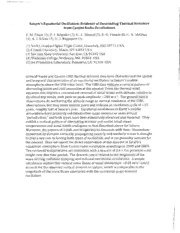
NASA Technical Reports Server (NTRS) 20110005652: Saturn's Equatorial Oscillation: Evidence of Descending Thermal Structure from Cassini Radio Occultations PDF
Preview NASA Technical Reports Server (NTRS) 20110005652: Saturn's Equatorial Oscillation: Evidence of Descending Thermal Structure from Cassini Radio Occultations
Saturn's Equatorial Oscillation: Evidence of Descending Thermal Structure from Cassini radio Occultations F. M. Flasar• (1), R J. Schinder (2), E. A. Marouf (3). R. G. French (14), C. A. McGhee (=1), A. J. Kliore (5), i^1. J. Rappaport (5) (1)NASA Goddard Space Flight Center, Greenbelt. MD 20771 USA (2)Cornell University, Ithaca, NY 14853 USA (3)San lose State University, San lase, CA 95192 USA (4) Wellesley College, Wellesley, MA 02841 USA (5)let Propulsion Laboratory, Pasadena, CA 91109 USA Ground-based and Cassini CIRS thermal-infrared data have characterized the spatial and temporal characteristics of an equatorial oscillation in Saturn's middle atmosphere above the 100-mbar level. The CIRS data indicate a vertical pattern of alternating warm and cold anomalies at the equator. From the thermal wind equation this implies a concomitant reversal of zonal winds with attitude, relative to the cloud-top winds, with peals-to-peak amplitude —200 rn s-r. The ground-based observations do not having the altitude range or vertical resolution of the CIRS observations, but they cover several years and indicate an oscillation cycle of —1 years, roughly half of Saturn's year. Equatorial oscillations in Earth's middle atmosphere have primarily exhibited either quasi-biennial or semi-annual "periodicities," and both types have been extensively observed and modeled. They exhibit a vertical pattern of alternating warmer and cooler zonal-mean temperatures and zonal winds analogous to that described above for Saturn. Moreover, the pattern of winds and temperatures descends with time. Momentum deposition by damped vertically propagating easterly and westerly waves is thought to play a trey role in forcing both types of oscillation, and it can plausibly account for the descent. Here we report the direct observation of this descent in Saturn's equatorial atmosphere from Cassini radio occultation soundings in 2005 and 2009. The retrieved temperatures are consistent with a descent of 0.6 x the pressure scale height over this time period. The descent rate is related to the magnitude of the wave forcing, radiative damping, and induced meridional circulations. A simple calculation implies that vertical wave fluxes of zonal momentum —0.05 m l-s-2 could account for the observed vertical descent on Saturn, which is comparable to the magnitude of the wave fluxes associated with the terrestrial quasi-biennial oscillation.
